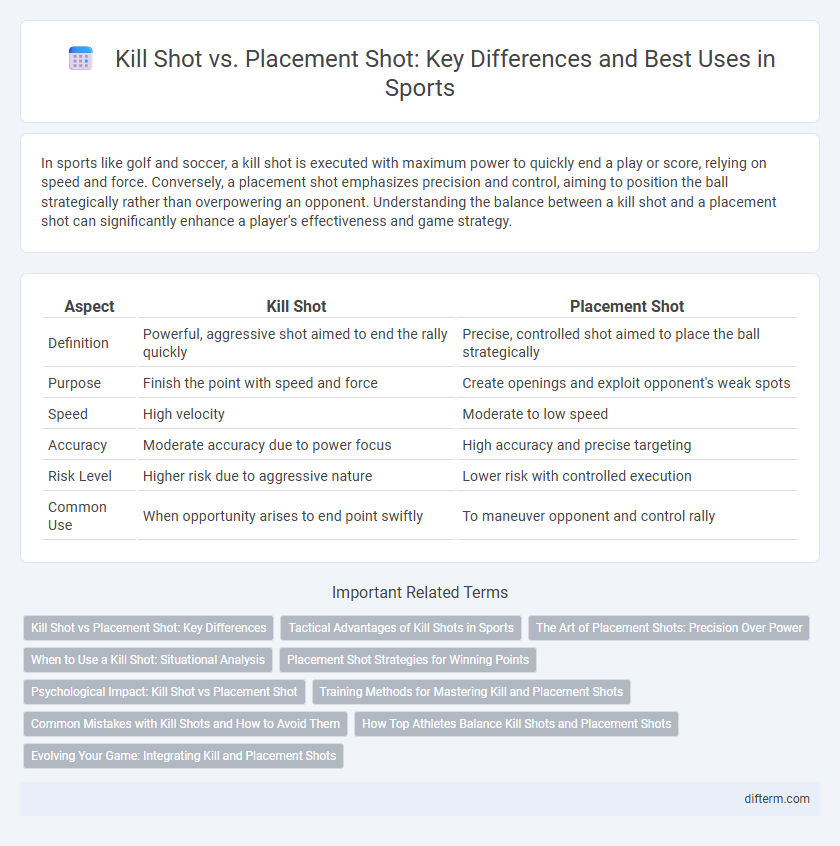In sports like golf and soccer, a kill shot is executed with maximum power to quickly end a play or score, relying on speed and force. Conversely, a placement shot emphasizes precision and control, aiming to position the ball strategically rather than overpowering an opponent. Understanding the balance between a kill shot and a placement shot can significantly enhance a player's effectiveness and game strategy.
Table of Comparison
| Aspect | Kill Shot | Placement Shot |
|---|---|---|
| Definition | Powerful, aggressive shot aimed to end the rally quickly | Precise, controlled shot aimed to place the ball strategically |
| Purpose | Finish the point with speed and force | Create openings and exploit opponent's weak spots |
| Speed | High velocity | Moderate to low speed |
| Accuracy | Moderate accuracy due to power focus | High accuracy and precise targeting |
| Risk Level | Higher risk due to aggressive nature | Lower risk with controlled execution |
| Common Use | When opportunity arises to end point swiftly | To maneuver opponent and control rally |
Kill Shot vs Placement Shot: Key Differences
Kill shots prioritize power and speed to end a rally quickly, aiming for a winner with minimal opponent recovery time. Placement shots emphasize precision and control, targeting difficult court areas to outmaneuver opponents and extend play strategically. Understanding the tactical differences between these shots enhances a player's ability to adapt during matches.
Tactical Advantages of Kill Shots in Sports
Kill shots in sports offer tactical advantages by enabling players to swiftly end rallies with powerful, precise strikes that catch opponents off-guard. Their aggressive nature disrupts the rhythm of opposing players, reducing their reaction time and limiting strategic counterattacks. Mastering kill shots enhances a player's offensive arsenal, creating scoring opportunities and shifting momentum decisively in competitive matches.
The Art of Placement Shots: Precision Over Power
Placement shots prioritize precision and strategic ball positioning over raw power, allowing players to exploit opponents' weaknesses by targeting specific areas on the court. Mastery of these shots requires excellent control, touch, and anticipation, enabling subtle angles and spin to outmaneuver adversaries. This technique contrasts with kill shots, which rely on speed and force to finish points quickly, making placement shots essential for sustained rally success and tactical gameplay.
When to Use a Kill Shot: Situational Analysis
The Kill Shot is most effective in situations requiring immediate point closure, especially when an opponent is out of position or off balance. It is ideal during fast-paced rallies where aggressive play can capitalize on weak returns or open court spaces. Employing a Kill Shot strategically maximizes pressure, forcing errors and securing points in critical match moments.
Placement Shot Strategies for Winning Points
Effective placement shot strategies focus on precision and exploiting opponents' weaknesses by targeting open spaces and varying shot angles. Using deep and short placements forces opponents out of position, creating opportunities to dictate the rally tempo. Consistently executing placement shots with controlled pace and spin increases the chances of winning points by reducing unforced errors and enhancing shot unpredictability.
Psychological Impact: Kill Shot vs Placement Shot
The psychological impact of a kill shot in sports creates immediate pressure on opponents by signaling aggression and dominance, often causing hesitation or defensive errors. In contrast, a placement shot strategically exploits spatial weaknesses, forcing opponents into a prolonged state of uncertainty and mental fatigue. Mastery of both shot types disrupts opponent focus and can shift momentum crucially during high-stakes competition.
Training Methods for Mastering Kill and Placement Shots
Training methods for mastering kill shots emphasize explosive power drills and precision targeting exercises to improve shot speed and accuracy. Placement shot training focuses on developing finesse through controlled touch drills and situational practice that enhances strategic ball placement. Incorporating resistance training, video analysis, and repetitive shot execution accelerates skill acquisition for both kill and placement shots in competitive sports.
Common Mistakes with Kill Shots and How to Avoid Them
Common mistakes with kill shots in sports include poor timing, resulting in weak or off-target hits, and improper body positioning that reduces power and accuracy. To avoid these errors, players should focus on maintaining a balanced stance, ensuring proper wrist snap for control, and practicing consistent hand-eye coordination. Drills that emphasize precision and timing can significantly improve the effectiveness of kill shots compared to placement shots.
How Top Athletes Balance Kill Shots and Placement Shots
Top athletes master the balance between kill shots and placement shots by analyzing opponent positioning and game context to decide when to end rallies decisively or extend play strategically. They use kill shots during high-pressure moments to capitalize on weak returns, while deploying precise placement shots to create openings and control the court's pace. This tactical versatility enhances their scoring efficiency and adaptability across diverse match scenarios.
Evolving Your Game: Integrating Kill and Placement Shots
Mastering the balance between kill shots and placement shots revolutionizes competitive gameplay by enhancing aggressive precision and strategic positioning. Incorporating kill shots demands explosive power and timing to finish points decisively, while placement shots emphasize accuracy and control to exploit opponent weaknesses. Elevating your game involves seamless transitions between these techniques, maximizing scoring opportunities through adaptive shot selection and situational awareness.
Kill Shot vs Placement Shot Infographic

 difterm.com
difterm.com